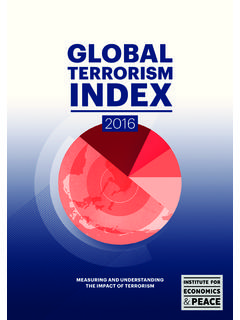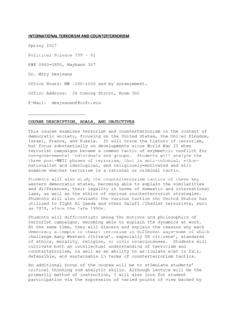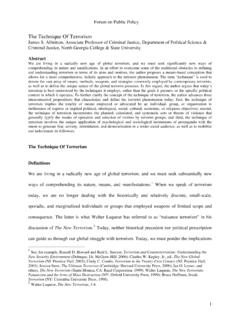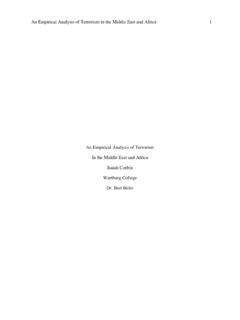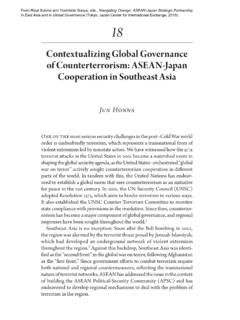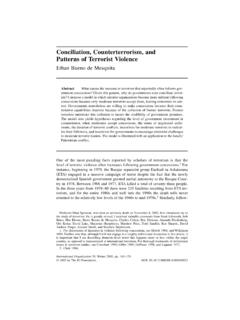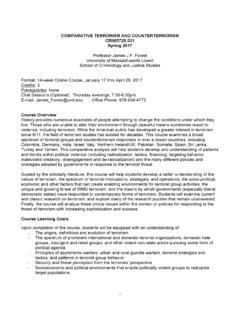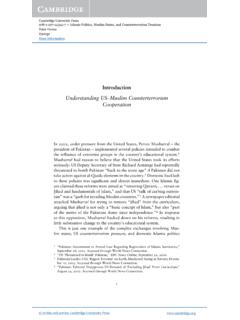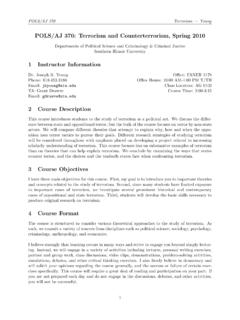Transcription of The Past and Future of Terrorism Research - USC CREATE
1 CREATE Research Archive Non-published Research Reports 2009. The Past and Future of Terrorism Research Todd Sandler University of Texas at Dallas, Follow this and additional works at: Recommended Citation Sandler, Todd, "The Past and Future of Terrorism Research " (2009). Non-published Research Reports. Paper 82. This Article is brought to you for free and open access by CREATE Research Archive. It has been accepted for inclusion in Non-published Research Reports by an authorized administrator of CREATE Research Archive. For more information, please contact Revista de Econom a Aplicada E N mero 50 (vol. XVII), 2009, p gs. 5 a 25. A. THE PAST AND Future OF. Terrorism Research . TODD SANDLER*. School of Economic, Political & Policy Sciences This paper highlights five areas where economic analysis of Terrorism has had the greatest policy relevance during the last 30 years. These areas involve evaluating the effectiveness of counterterrorism actions, identifying the causes of Terrorism , measuring the economic ramification of Terrorism , analyzing the time-series dynamics of terrorist events, and formulating game-theoretic representations of Terrorism .
2 The paper's pri- mary novelty lies in synthesizing past Research and in identifying the key policy-relevant issues that require additional analysis. These issues in- clude understanding the operation of global terrorist networks, ascertain- ing the payback of counterterrorism strategies, evaluating the returns from alternative forms of international cooperation, and investigating the strategic aspects of suicide Terrorism . A procedure for tackling each of these policy concerns is offered. Key words: Terrorism , counterterrorism , benefit-cost analysis, game the- ory, policy effectiveness, economic consequences JEL Classification: D74, H41, H56. S. ince the four terrorist skyjackings on 11 September 2001 (hereafter, 9/11), economists have taken a strong interest in applying economic methods to the study of Terrorism and counterterrorism . This post-9/11 effort has been, partly, supported by the Centers of Excellence, funded by the US Depart- ment of Homeland Security.
3 Economic Research on this topic dates back to Landes' (1978) study of the deterrent effects of US antiterrorism policies against skyjackings during 1961-1976. In particular, Landes was interested in the effecti- veness of metal detectors used to screen passengers after detectors' installation on 5 January 1973. Economists' Research efforts have greatly added to our un- derstanding of Terrorism by stressing a rational-choice model in which terrorists are viewed as optimizing an objective, subject to constraints. Terrorist rationality (*) Todd Sandler is the Vibhooti Shukla Professor of Economics and Political Economy. This study was funded, in part, by the US Department of Homeland Security (DHS) through the Center for Risk and Economic Analysis of Terrorism Events ( CREATE ) at the University of Southern Ca- lifornia, grant number 2007-ST-061-000001. However, any opinions, findings, conclusions or re- commendations are solely those of the author and do not necessarily reflect the views of DHS or CREATE .
4 The author gratefully acknowledges helpful comments from an anonymous referee. This paper is based on a keynote talk given at Simposio de Analisis Economico 2008 in Zaragoza. 5. Revista de Econom a Aplicada is not based on the legitimacy or desirability of their preferences or objectives, but rather on their appropriate (and predictable) response to changes in their constraints, which are determined by terrorist resources and the policy decisions of governments. For example, official steps that make skyjackings more costly should induce terrorists to shift to relatively less costly alternative modes of hos- tage taking ( , kidnappings). Similarly, terrorists' choices affect governments'. objectives and constraints. Given this strategic interaction among targeted go- vernments and terrorists, game theory has proven to be a useful tool in unders- tanding interactive choices of these bitter adversaries. This game-theoretic inte- rest has spilled over into political science (see, , Bueno de Mesquita, 2005a, b; Powell, 2007).
5 Economists have also applied econometric methods to test alternative hypot- heses , does poverty cause Terrorism (Abadie, 2006; Krueger and Malecko- va, 2003) and what is the impact of Terrorism on tourism (Drakos and Kutan, 2003; Enders et al., 1992). Many Terrorism -related questions have been investiga- ted with a variety of techniques, which have included hazard (time-to-failure) mo- dels, discrete-choice models, panel estimations, time-series estimations, and si- multaneous equations. The latter are particularly appropriate when the reduced-form equations derive from a game-theoretic foundation, since one agent's choice is not independent of those of other agents. For example, two go- vernments' choices of defensive and proactive measures against a common terro- rist threat result in best-response paths that have correlated errors. Simultaneous- equation estimations will become more prevalent as data on government actions are available.
6 To date, most data sets primarily record the actions of the terrorists during incidents. With the help of empirical methods, economists have investiga- ted the effectiveness of alternative counterterrorism policies , the impact of retaliatory raids on the prevalence of Future incidents or the influence of UN con- ventions and resolutions on particular types of terrorist incidents. This article has two main purposes: (i) to highlight significant economic re- search findings to date, and (ii) to indicate fruitful areas for Future economic re- search on Terrorism . The paper's main novelty lies in identifying how economic methods can answer essential questions that have yet to be answered. Procedures for answering these questions are also indicated. To assist readers to understand unanswered issues, I must first indicate where economic analysis has had the greatest success in studying Terrorism . These successes include evaluating coun- terterrorism policies (Section 1), measuring the economic consequences of terror- ism (Section 2), investigating the causes of Terrorism (Section 3), identifying time-series dynamics of terrorist events (Section 4), and building game-theoretic models (Section 5).
7 Future directions then follow and include the study of net- worked terrorists (Section 6), the payback of alternative counterterrorism strate- gies (Section 7), the evaluation of international cooperation (Section 8), and the strategic analysis of suicide Terrorism (Section 9). Section 10 concludes with ad- ditional Future directions. 6. The Past and Future of Terrorism Research 1. EFFECTIVENESS OF counterterrorism POLICIES. The most important and useful contribution of economic analysis to the study of Terrorism is its development of estimates for the effectiveness of coun- terterrorism measures. Prior to economic analysis, evaluation of alternative poli- cies was based on casual empiricism with no quantification of policy effective- ness. In his seminal economic study, Landes (1978) used Gary Becker's crime and punishment model to derive an offense function, O, to ascertain the deterrent effect of explicit policy decisions on the number of US hijackings.
8 The incidence of these skyjackings was related to the offender's estimate of the likelihood of ap- prehension (Pa), his or her estimate of the conditional probability of conviction and incarceration (Pc), the monetary value of the sentence (S), the cost of appre- hension with sentencing (C), a vector of variables (Z) reflecting wealth differ- ences between the destination country and the home country, and other variables (income) (X). Thus, the offense function is: O = O(Pa, Pc, S, C, Z, X) [1]. in which the probability of apprehension is influenced by metal detectors after January 1973. Offenses denote the quarterly number of skyjackings. Landes (1978, p. 12) found that an increase in the probability of apprehen- sion owing to metal detectors had a negative and highly significant influence on the incidence of skyjackings a reduction of to US skyjackings per quar- ter. Other noteworthy deterrents included a higher probability of conviction and longer prison sentences.
9 In a second set of regressions, Landes (1978) related the above deterrents to the length of time between skyjackings. Effective deterrents lengthened this time interval. He showed that a greater probability of apprehen- sion, a greater chance of conviction, and longer prison sentences slowed the ar- rival rate of skyjackings, thereby serving as effective deterrents. Higher unem- ployment rates increased the frequency of skyjackings so that the opportunity costs in the home country made a difference. Although the Landes (1978) article is a landmark, he did not account for ter- rorists' abilities to substitute among modes of attacks in response to the higher metal-detector-related costs associated with skyjackings. Hence, his benefit esti- mate for metal detectors was solely based on the fewer skyjackings that ranged from 41 to 60 for 1973-76, and hence did not properly estimate these benefits (Landes, 1978, p. 21). Enders and Sandler (1993, 2006) used an alternative methodology for judging the benefits for metal detectors.
10 In particular, they ap- plied a vector autoregression (VAR) technique where multiple time series are in- vestigated simultaneously to spot substitutions and complementaries among at- tack modes. For one set of runs, they used four time series: skyjackings, other hostage incidents ( , kidnappings, nonaerial hijackings, and building seizures), attacks against protected persons ( , nonhostage incidents against diplomats and other protected persons) and other incidents. Figure 1 from Enders and Sandler (2006) displays the four time series where actual series are in broken lines and predicted series are in solid lines. In each of the four panels, the first vertical line at the first quarter of 1973 denotes the introduction of metal detectors. As can be 7. Revista de Econom a Aplicada seen in the skyjacking panel, skyjackings dropped precipitously after metal detec- tors were installed, consistent with Landes' US findings; however, other kinds of hostage incidents rose greatly at the same time, limiting the gains from metal de- tectors.
